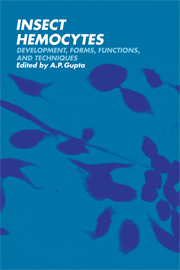Book contents
- Frontmatter
- Contents
- Preface
- List of contributors
- Part I Development and differentiation
- 1 Embryonic hemocytes: origin and development
- 2 Postembryonic development and differentiation: hemopoietic tissues and their functions in some insects
- 3 Multiplication of hemocytes
- Part II Forms and structure
- Part III Functions
- Part IV Techniques
- Indexes
2 - Postembryonic development and differentiation: hemopoietic tissues and their functions in some insects
Published online by Cambridge University Press: 04 August 2010
- Frontmatter
- Contents
- Preface
- List of contributors
- Part I Development and differentiation
- 1 Embryonic hemocytes: origin and development
- 2 Postembryonic development and differentiation: hemopoietic tissues and their functions in some insects
- 3 Multiplication of hemocytes
- Part II Forms and structure
- Part III Functions
- Part IV Techniques
- Indexes
Summary
Introduction
The blood cells of many higher animals are formed in specialized tissues called hemocytopoietic tissues (blood-cell-making tissues; poiesis = “making”) or hemopoietic tissues. Although less accurate, the latter term is generally used to mean the same thing as hemocytopoietic tissues and will be preferred in this chapter.
Hemopoietic tissues are concerned with producing different lines of blood cells and delivering them into the blood; in some animals they may also function to remove dying or dead cells and histolytic debris from circulation. This function is assumed by phagocytic cells that originate from a particular cell lineage, generally called reticular or reticuloendothelial cells; it is this cell type that gives to hemopoietic tissues a characteristic reticular arrangement. It must be stressed that a third major function of hemopoietic tissues in higher animals may be immunologic, involving specialized cells such as lymphocytes and plasmocytes.
That in at least some insects definite hemopoietic tissues are present was reported near the end of the last century (Kowalevsky, 1889). However, discrepancies obviously exist between the organizational level of hemopoietic tissues (or their equivalents) in different insect orders; in addition, this organization may change during the development in the same species, as will be explained for Calliphora.
These differences are the major source of the controversies about the postembryonic origin of hemocytes that existed between Kowalevsky (1889) and Cuénot (1896). Another source is the lack of quantitative data.
Jones (1970) published an exhaustive report on these controversies (250 references), and it is unnecessary to duplicate such a review here (see also Chapter 3).
- Type
- Chapter
- Information
- Insect HemocytesDevelopment, Forms, Functions and Techniques, pp. 29 - 66Publisher: Cambridge University PressPrint publication year: 1979
- 11
- Cited by



